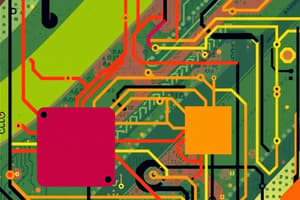Podcast
Questions and Answers
Capacitors are used to store and release mechanical energy.
Capacitors are used to store and release mechanical energy.
False (B)
Inductors can be used to regulate the voltage of an AC circuit.
Inductors can be used to regulate the voltage of an AC circuit.
False (B)
Circuits only play a minor role in electricity generation and distribution.
Circuits only play a minor role in electricity generation and distribution.
False (B)
Understanding circuits is unnecessary to comprehend how electricity is used in daily life.
Understanding circuits is unnecessary to comprehend how electricity is used in daily life.
Resistors are not mentioned as components used in building circuits.
Resistors are not mentioned as components used in building circuits.
Circuits are open pathways that allow electric current to flow.
Circuits are open pathways that allow electric current to flow.
Switches in a circuit control the amount of current flowing through it.
Switches in a circuit control the amount of current flowing through it.
Conductors like copper wires resist the flow of electricity in a circuit.
Conductors like copper wires resist the flow of electricity in a circuit.
Resistors are components in a circuit that allow electricity to flow freely.
Resistors are components in a circuit that allow electricity to flow freely.
Electric current flows mainly in the form of protons in circuits.
Electric current flows mainly in the form of protons in circuits.
Study Notes
Electricity: Understanding Circuits
Introduction
Electricity is a fundamental aspect of modern life, powering everything from our homes to our industries. One key component of electricity generation and distribution is the circuit. Understanding circuits is crucial for understanding how electricity flows and how it can be harnessed for various applications. In this article, we will delve into the concept of circuits, their components, and their role in the broader context of electricity production and distribution.
What are Circuits?
In the context of electricity, a circuit is a closed pathway that allows electric current to flow. This flow of electrical charge, typically in the form of electrons, is the essence of all electrical devices, from simple light bulbs to complex computers.
Components of Circuits
Circuits are built using various components that facilitate the flow of electricity. Some of the most common components include:
-
Conductors: These are materials, such as copper wires, that allow electricity to flow through them. Conductors are essential for connecting different parts of a circuit and allowing the flow of electric current.
-
Switches: Switches allow the flow of electricity to be controlled. They can be used to turn on or off a circuit, or to control the direction of the current flow.
-
Resistors: These components resist the flow of electricity, which can be used to control the amount of current flowing through a circuit. They also help to protect circuits from overloads and provide a means of measuring current.
-
Capacitors: Capacitors store and release electrical energy. They can be used to smooth out voltage spikes in a circuit, act as a temporary power source, or help to stabilize the frequency of an alternating current (AC) circuit.
-
Inductors: Inductors store energy in a magnetic field. They can be used to regulate the current flow in a circuit, provide energy storage, or act as a transformer to change the voltage of an AC circuit.
Electricity Generation and Distribution
Electricity is generated in power plants using various methods, such as fossil fuel combustion, nuclear reactions, or renewable sources like wind and solar power. Once generated, electricity is distributed through a network of power lines and substations to reach homes and businesses. In this process, circuits play a crucial role, as they allow electricity to flow efficiently and safely from the power plant to the end user.
Conclusion
In summary, circuits are an integral part of electricity generation and distribution. They are built using various components, such as conductors, switches, resistors, capacitors, and inductors, which enable the flow of electricity and allow for control, regulation, and measurement. Understanding circuits is essential for understanding how electricity is generated, distributed, and used in our daily lives.
Studying That Suits You
Use AI to generate personalized quizzes and flashcards to suit your learning preferences.
Description
Explore the fundamentals of circuits in electricity, including their components, role in electricity generation and distribution, and how they facilitate the flow of electrical charge. Learn about conductors, switches, resistors, capacitors, and inductors, and their functions within a circuit.




